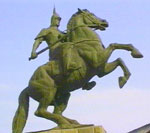Zhaoling Tomb is popularly named 'Beiling,' meaning Northern Tomb because of its location in the northern suburb of the ancient city. The tomb began to be built in 1643 and was completed in 1651, and now houses the burial site of Huang Taiji, the second emperor in the early Qing dynasty.

It is said that Huangtaiji selected this burial ground on one of his hunting adventures. In his later years, he had been searching for a resting place for himself and his empress. He had consulted many astrologists and fortune tellers, but finally one day, when heading out to the northern suburbs to hunt, a rabbit caught his eye. He followed it and was led to an open field, where he found black crows sitting on the land. Black crows are a sacred animal in Manchu culture and thus it was decided that his burial ground would be in the northern part of the city… today's Beiling.
Along the sides of this path are many creatures that guard the emperor's tomb, including lions, camels, and elephants. However, two of the most important structures are horses. Xiao Bai and Da Bai. Little White and Big White. Let's take a look.
An emperor is often remembered for his battles, and Huang Taiji was no exception. His favorite horses he took into battle were called Big White and Little White. At his death, he ordered that they be placed at the site of his burial.
This tourist attraction is often called the Square city, because emperor Huang Taiji hoped his burial ground would be designed like his home in the imperial palace, square on four sides.
This tomb is the grandest of the three tombs in Shenyang covering an area of 4,500,000 square meters.
Long En Men is the front gate of the Square Bastion.

Hey Yin, what's this?
Yin: Oh, that's a lock. You can put this pole through the two holes and lock the gate.
So why is it locked from the outside?
Yin:Well, if you think about it. This is a mausoleum so there are no living people inside. Thus, it needs to be locked on the outside.

